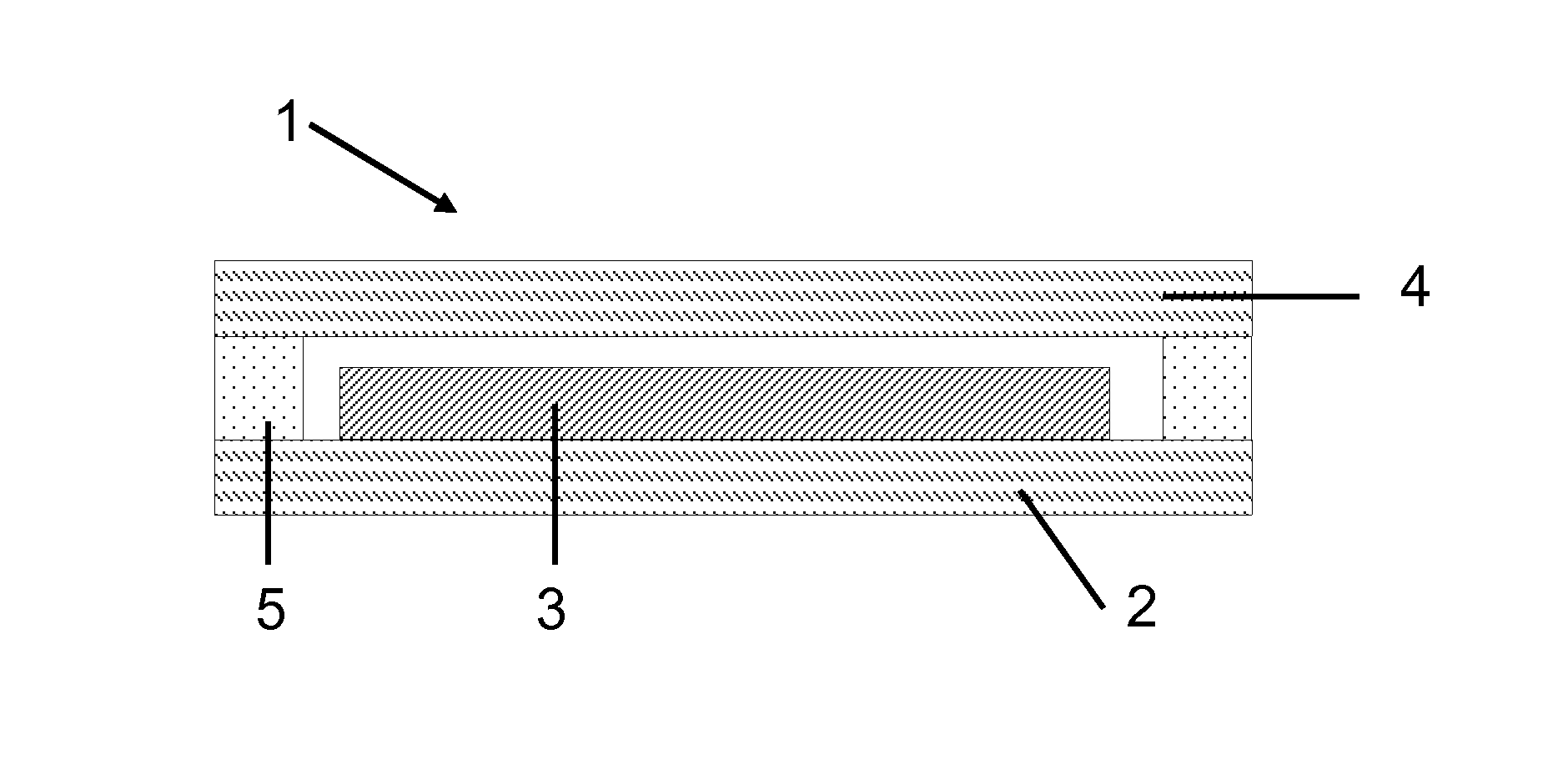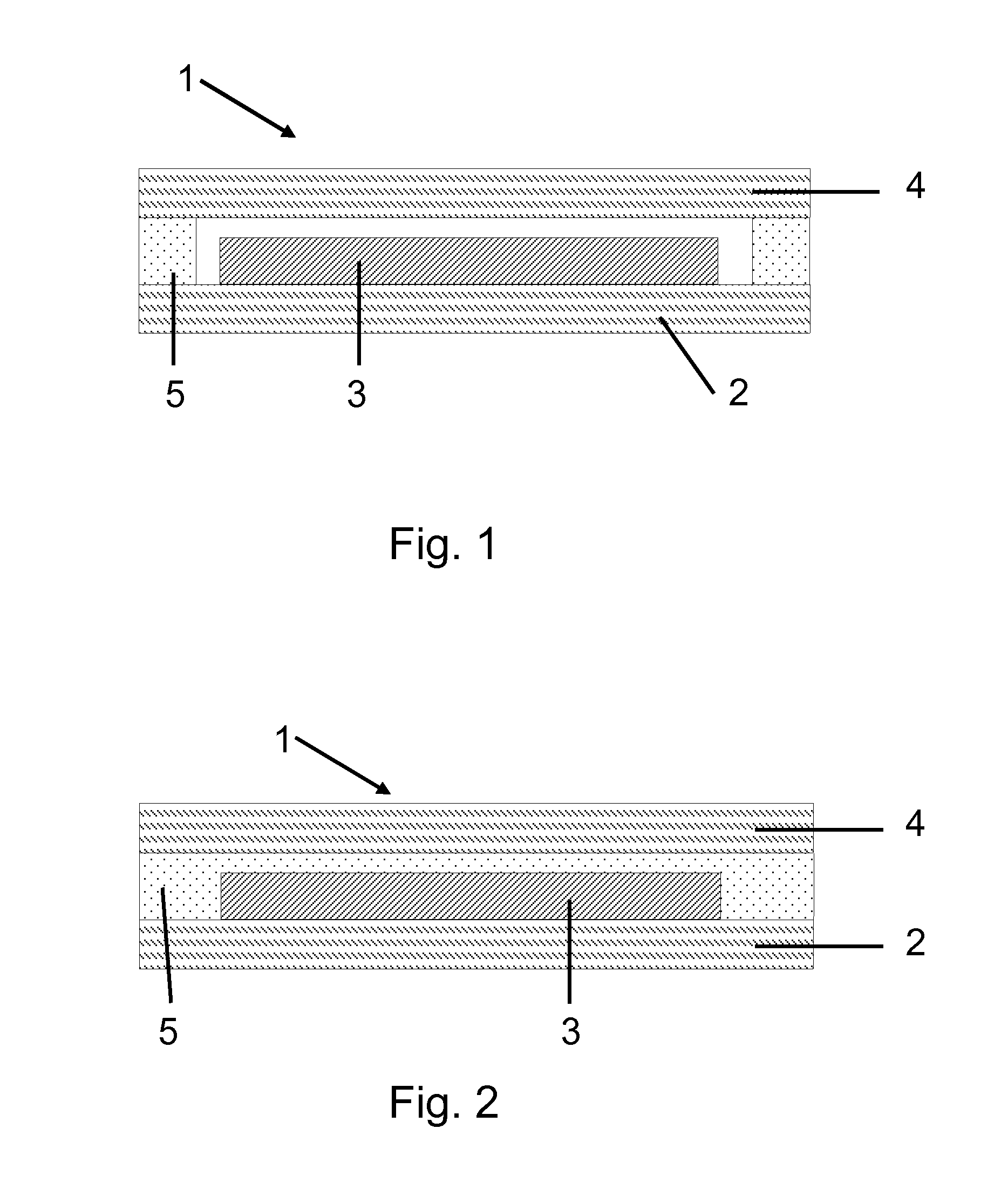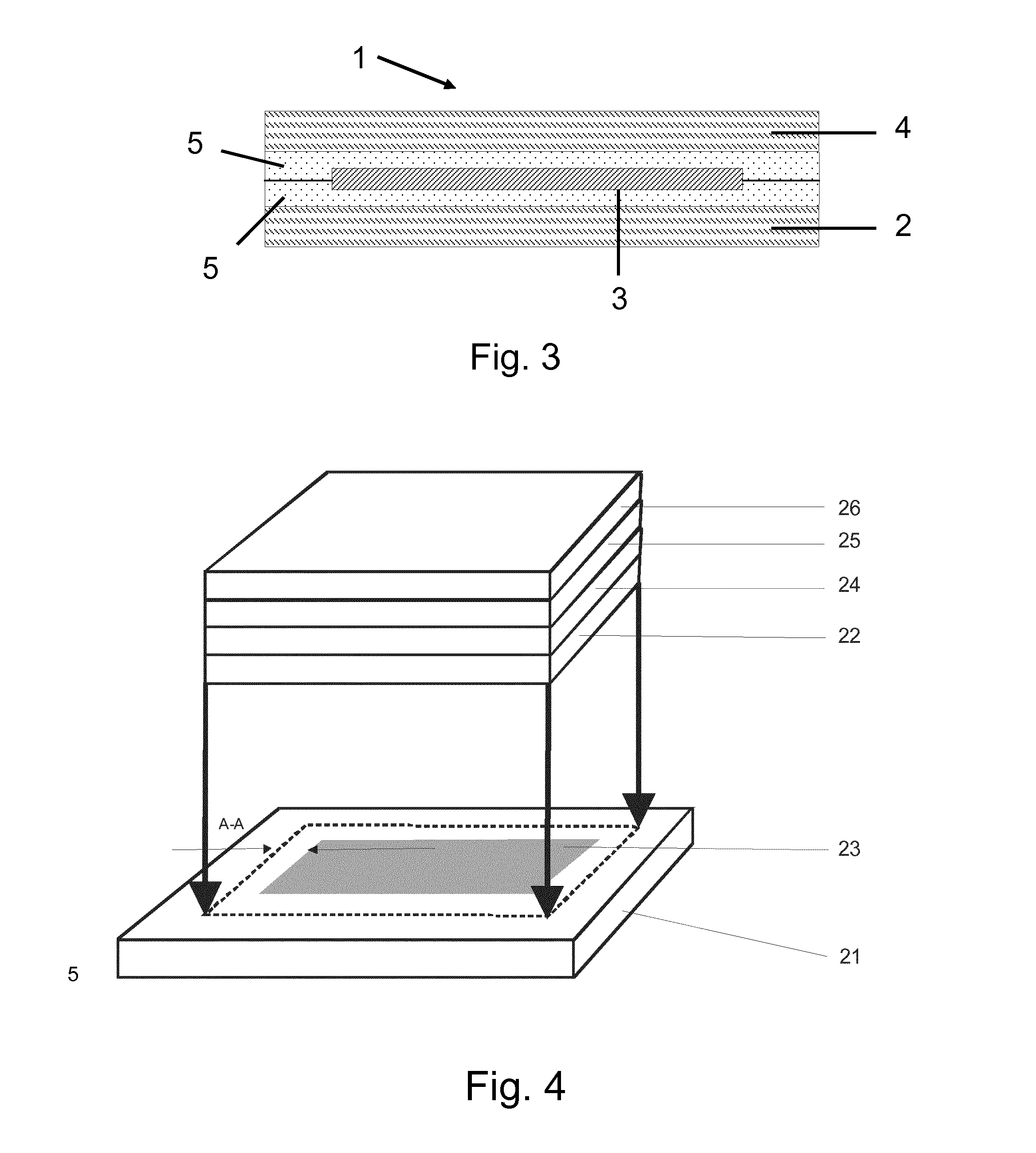Pressure-sensitive adhesive material particularly for encasing an electronic arrangement
Active Publication Date: 2015-08-27
TESA SE
View PDF3 Cites 18 Cited by
- Summary
- Abstract
- Description
- Claims
- Application Information
AI Technical Summary
Benefits of technology
The present invention provides an adhesive that has excellent barrier properties against water vapor and oxygen, and good interfacial adhesion to various substrates. The adhesive is flexible and easy to apply in electronic arrangements and encapsulation. It can achieve a good barrier effect in a simple roll-to-roll process, and is suitable for heating before or after application. The adhesive has a low volume permeation of water vapor and oxygen, which prevents the adhesive from causing damage to the electronic arrangement. These properties make the adhesive ideal for use in encapsulating (opto)electronic arrangements.
Problems solved by technology
A perceived technical challenge for realization of sufficient lifetime and function of (opto)electronic arrangements in the area of organic and / or inorganic (opto)electronics, especially in the area of organic (opto)electronics, is the protection of the components they contain against permeants.
A large number of (opto)electronic arrangements in the area of organic and / or inorganic (opto)electronics, especially where organic raw materials are used, are sensitive not only to water vapor but also to oxygen, and for many arrangements the penetration of water vapor is classed as a relatively severe problem.
A major barrier to the dye solar cell technology on its path from the laboratory scale to extensive applications is the long-term-stable sealing of the electrolyte.
For non-flexible constructions, glass or metal substrates are used, which offer a high permeation barrier but are very susceptible to mechanical loads.
Furthermore, these substrates give rise to a relatively high thickness of the arrangement as a whole.
Owing to incomplete wetting of the surface of the arrangement and to pores that remain, a low capacity for flow on the arrangement may reduce the barrier effect at the interface, since it permits lateral ingress of oxygen and water vapor independently of the properties of the adhesive.
Often, in the case of highly crosslinked or highly crystalline materials, relatively low values are obtained for D. Highly crystalline materials, however, are generally less transparent, and greater crosslinking results in a lower flexibility.
A low solubility term S is usually insufficient for achieving good barrier properties.
Full-area bonding is hard to achieve, owing to the contraction that occurs as a result of curing, since in the course of curing there are stresses between adhesive and substrate that may in turn lead to delamination.
For instance, low molecular mass constituents (VOCs—volatile organic compounds) may damage the sensitive electronic structures in the arrangement and may hinder production operations.
The adhesive must be applied, laboriously, to each individual constituent of the arrangement.
Moreover, the nature of application prevents a rapid continuous operation, and the laminating step that is subsequently needed may also make it more difficult, owing to the low viscosity, to achieve a defined layer thickness and bond width within narrow limits.
Furthermore, the residual flexibility of such highly crosslinked adhesives after curing is low.
In the low temperature range or in the case of 2-component systems, the use of thermally crosslinking systems is limited by the potlife, in other words the working time until gelling has taken place.
In the high temperature range, and particularly in the case of long reaction times, in turn, the sensitive (opto)electronic structures limit the possibility of using such systems.
The maximum temperatures that can be employed in the case of (opto)electronic structures are often 60° C., since above even this temperature there may be initial damage.
However, no specific examples are given that lead to particularly low volume permeation and interfacial permeation in conjunction with high transparency and flexibility.
Method used
the structure of the environmentally friendly knitted fabric provided by the present invention; figure 2 Flow chart of the yarn wrapping machine for environmentally friendly knitted fabrics and storage devices; image 3 Is the parameter map of the yarn covering machine
View moreImage
Smart Image Click on the blue labels to locate them in the text.
Smart ImageViewing Examples
Examples
Experimental program
Comparison scheme
Effect test
example 1
[0164]
thermoplastic fluoroelastomer Daikin Dai-EL G740095 wt %liquid fluoroelastomer Daikin Dai-EL G-101 5 wt %
example 2
[0165]
thermoplastic fluoroelastomer Daikin Dai-EL G740080 wt %liquid fluoroelastomer Daikin Dai-EL G-10120 wt %
example 3
[0166]
thermoplastic fluoroelastomer Daikin Dai-EL G740060 wt %liquid fluoroelastomer Daikin Dai-EL G-10140 wt %
the structure of the environmentally friendly knitted fabric provided by the present invention; figure 2 Flow chart of the yarn wrapping machine for environmentally friendly knitted fabrics and storage devices; image 3 Is the parameter map of the yarn covering machine
Login to View More PUM
| Property | Measurement | Unit |
|---|---|---|
| Temperature | aaaaa | aaaaa |
| Temperature | aaaaa | aaaaa |
| Temperature | aaaaa | aaaaa |
Login to View More
Abstract
Pressure-sensitive adhesive material for encasing an electronic arrangement to prevent permeate, which material comprises at least 70 percent by weight of a mixture of at least one fluorine-containing thermoplastic elastomer and at least one fluorine-containing liquid elastomer, wherein the mass ratio of the fluorine-containing liquid elastomer to the fluorine-containing thermoplastic elastomer is between 5:95 to 55:45
Description
[0001]This is a 371 of PCT / EP2013 / 064145 filed 4 Jul. 2013, which claims foreign priority benefit under 35 U.S.C. 119 of German Patent Applications 10 2012 215 136.2 filed 24 Aug. 2012 and 10 2012 219 877.6, filed 30 Oct. 2012, the entire contents of which are incorporated herein by reference.BACKGROUND OF THE INVENTION[0002]The present invention relates to a pressure-sensitive adhesive particularly for encapsulating an electronic arrangement.[0003](Opto)electronic arrangements are being used with ever-increasing frequency in commercial products or are close to market introduction. Such arrangements comprise organic or inorganic electronic structures, examples being organic, organometallic or polymeric semiconductors or else combinations of these. Depending on the desired application, these arrangements and products are rigid or flexible in form, there being an increasing demand for flexible arrangements. Arrangements of this kind are produced, for example, by printing techniques, s...
Claims
the structure of the environmentally friendly knitted fabric provided by the present invention; figure 2 Flow chart of the yarn wrapping machine for environmentally friendly knitted fabrics and storage devices; image 3 Is the parameter map of the yarn covering machine
Login to View More Application Information
Patent Timeline
 Login to View More
Login to View More IPC IPC(8): C09J127/12C08K3/22H05K5/06C08K11/00
CPCC09J127/12C08K11/00C08K2003/222H05K5/065C08K3/22C09J127/16H01L2924/0002C08L27/16H10K59/873H01L2924/00H10K50/844
Inventor KEITE-TELGENBUSCHER, KLAUSELLINGER, JAN
Owner TESA SE
Features
- R&D
- Intellectual Property
- Life Sciences
- Materials
- Tech Scout
Why Patsnap Eureka
- Unparalleled Data Quality
- Higher Quality Content
- 60% Fewer Hallucinations
Social media
Patsnap Eureka Blog
Learn More Browse by: Latest US Patents, China's latest patents, Technical Efficacy Thesaurus, Application Domain, Technology Topic, Popular Technical Reports.
© 2025 PatSnap. All rights reserved.Legal|Privacy policy|Modern Slavery Act Transparency Statement|Sitemap|About US| Contact US: help@patsnap.com



